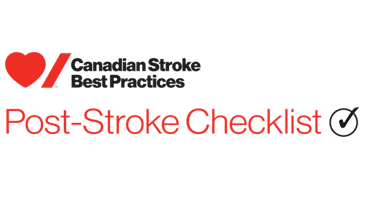Notes
Refer to Acute Stroke Management module, Section 10 (Advance Care Planning) and Section 11 (Palliative Care) for comprehensive recommendations on these topics. The recommendations presented below are specifically nuanced to the VCI population and based on specific evidence in populations with VCI and or dementia. (Heran et al. 2022)
Recommendations and/or Clinical Considerations
5.1 Advance Care Planning
- Individuals with VCI, as well as their families and informal caregivers, should be informed about advance care planning options as early as possible following diagnosis due to the progressive nature of VCI [Strong recommendation; Low quality of evidence].
- Respectful and empathetic advance care planning should be integrated as part of a comprehensive care plan, taking into consideration the individual’s capacity for understanding and decision-making, their values and preferences, information regarding the individual’s health trajectory, understanding, prognosis, medically appropriate treatments and future medical care [Strong recommendation; Moderate quality of evidence]. Refer to definition of Consent in Definitions and Descriptions section for additional information.
- Advance care planning discussions should be documented and reassessed regularly with the individual with VCI, the healthcare team and substitute decision-maker, especially when there is a change in the individual’s health status [Strong recommendation; Low quality of evidence].
5.2 Palliative and End-of-Life Care
- A palliative approach should be considered when there is advanced vascular dementia, to optimize care and quality of life [Strong recommendation; Low quality of evidence].
- The care team should have discussions with the individual with VCI, and substitute decision-makers regarding the individual’s goals of care that include consideration of the individual’s capacity, diagnosis, prognosis, values, wishes (advance care plans), and whether care should focus on comfort or on prolonging life [Strong recommendation; Low quality of evidence].
- There should be regular communication with the individual with VCI, their family, and informal caregivers to ensure their goals and needs are being met and to reflect any changes in diagnosis or prognosis [Strong recommendation; Low quality of evidence].
- Topics to be discussed with individuals with VCI, families, and informal caregivers may include the appropriateness of life-sustaining measures, including mechanical ventilation, enteral/intravenous feeding, and intravenous fluids; less aggressive or withdrawal of vascular risk reduction strategies; and the purpose of all medications, including those for symptom management [Strong recommendation; Low quality of evidence].
- Palliative care discussions should be documented and reassessed regularly with the healthcare team and substitute decision-maker [Strong recommendation; Low quality of evidence].
- Individuals with VCI, families, informal caregivers, and the healthcare team should have access to palliative care specialists, particularly for consultation about individuals with difficult-to-control symptoms, complex or conflicted end-of-life decision-making, or complex psycho-social family issues [Strong recommendation; Low quality of evidence].
- Individuals with VCI, families, informal caregivers, and the healthcare team should have access to additional supports including spiritual care, grief counselling, and mental health professionals [Strong recommendation; Low quality of evidence].
- Each member of the healthcare team should understand their roles and responsibilities as defined by their respective provincial or territorial college or professional organization regarding discussions about medical assistance in dying (MAiD), particularly when they involve individuals with VCI [Strong recommendation; Low quality of evidence].
Section 5 Clinical Considerations
- Education should include the progressive nature of VCI and encourage individuals with VCI to consider making plans for their personal, health and financial affairs.
- Discuss the importance of the individual with VCI and their family and caregivers participating in advance care planning discussions, what it involves, why it is important, and the benefits of establishing an advance care plan. Therse plans may need to be reviewed periodically as VCI may change or progress over time.
- Providers should be aware of relevant provincial legislation related to determining capacity. If the individual has been deemed incapable of making specific decisions regarding their personal care, or financial capacity by the appropriate assessor or evaluator, the lawful substitute decision maker(s) should be identified.
- Referral to the local MAiD resource centre can be considered if further discussions are required.
- In the field of vascular cognitive impairment, the issue of agency to provide consent often arises. Throughout these recommendations, there is reference to the individual with VCI, their family and other informal caregivers. The individual with VCI retains the same rights to privacy of health information as any individual seeking healthcare services, under national and provincial legislation. It is acknowledged that at some point their capacity for providing consent, whether consent for others to be involved in their care and receive their personal health information, or consent for treatments, may change. Throughout these recommendations, the issue of consent is assumed to have been addressed by the healthcare team members with the individual and their alternate decision-makers where appropriate.
Palliative care and advance care planning (ACP) are two critical components of end-of-life care as patients in the advanced stages of dementia, their caregivers and family members navigate their way through the healthcare system. Advance care planning can give individuals with VCI or dementia a sense of control over an uncertain future while enabling them to participate directly in the decision-making process about future care. Palliative care focuses on the management of relief from pain and other distressing symptoms, such as agitation and swallowing difficulties, while helping to support the family physically, emotionally and spiritually.
People with lived experience stressed the importance of advance care planning among family members and loved ones and discussed how the concept may not be well-known. They talked about the difficulty that family members may experience when making healthcare decisions for someone else, especially if those discussions did not take place when the individual was competent and able to participate. People with lived experienced explained that although these types of conversations may be new or challenging, they ultimately allow the individual to have some control and allow their voice to be heard. These conversations can also support family members when they are faced with stressful decisions about the individual’s health. They also emphasized the importance of having advance care planning conversations throughout their lives, and to be aware that one conversation may not be enough as people’s wants and wishes can change over time. They also discussed the value of having a resource to guide these discussions, especially for those who haven’t considered advance care planning previously.
People with lived experience recognized that palliative and end-of-life discussion can be very challenging. They suggested it would be helpful if one person from the healthcare team could be designated to ensure appropriate conversations are held with the appropriate parties about palliative and end-of-life care needs. They stated that sometimes people need “permission” to know it’s okay to bring up the topic with family, friends, and loved ones, or with a healthcare provider, and having someone initiate the conversation in a supportive environment can be helpful. They expressed that palliative and end-of-life care wishes should be brought up and discussed before they are required, to help give the individual some control and let them express what they want and need for this time in their life.
To ensure people experiencing VCI receive timely assessments, interventions and management, interdisciplinary teams need to have the infrastructure and resources required. These may include the following components established at a systems level.
- Protocols for advance care planning to elicit goals for care and preferences of individuals with VCI and their family, and ensuring these are documented and communicated to decision-makers and healthcare team members.
- Information on advance care planning and links to local support organizations and their services for staff to share with individuals with VCI and families.
- Communication and skills training for physicians, nurses, and allied health professionals that addresses supporting patients and their families through advance care planning and dealing with potential conflicts over an individual with VCI’s wishes and decisions.
System indicators:
- Proportion of hospitals and communities with access to palliative care services for individuals with VCI.
Process indicators:
- Proportion of individuals with VCI who have been approached to participate in advance care planning and/or who have a documented conversation with a healthcare provider.
- Proportion of individuals with VCI who identify a substitute decision-maker.
- Proportion of individuals with VCI who complete a personal or advance care plan and have it documented on their chart.
Patient-oriented outcome and experience indicators:
- Proportion of individuals with VCI with advance care plans whose actual care was consistent with the care defined in their plan.
Measurement Notes
- Documentation for the advance care plan measures may appear in consult notes, nursing notes, social work notes, or physician notes.
- A copy of the advance care plan should ideally be included in the individual’s hospital and community care charts.
- Data quality may be an issue with some of these performance measures. Improved documentation should be promoted among healthcare professionals.
- Individuals with VCI and family experience surveys should be used to monitor care quality which includes end-of life experiences.
Resources and tools listed below that are external to Heart & Stroke and the Canadian Stroke Best Practice Recommendations may be useful resources for stroke care. However, their inclusion is not an actual or implied endorsement by the Canadian Stroke Best Practices team or Heart & Stroke. The reader is encouraged to review these resources and tools critically and implement them into practice at their discretion.
Healthcare provider information
- Advance Care Planning in Canada
- Canadian Virtual Hospice: My Grief Learning Modules
- Canadian Virtual Hospice: The Learning Hub
- Canadian Hospice Palliative Care Association Resource
- Canadian Virtual Hospice: Decisions
- Palliative Care Education for All Care Providers
- Burton and Payne Palliative Care Pathway
- Bernacki RE, Block SD. Serious Illness Communications Checklist. Virtual Mentor. 2013;15(12):1045–9.
- Registered Nurses Association of Ontario Guidelines for End-of-Life Care
Information for People with VCI, their Families and Caregivers
- Heart & Stroke: Vascular Cognitive Impairment Infographic and Journey Map
- Heart & Stroke: Your Stroke Journey
- Heart & Stroke: Post-Stroke Checklist
- Heart & Stroke: End-of-Life Care and Palliative Care
- Canadian Virtual Hospice: My Grief Learning Modules
- Canadian Virtual Hospice: The Learning Hub
- Advance Care Planning in Canada
- Canadian Hospice Palliative Care Association Resources
- Canadian Virtual Hospice: Decisions
- Government of Canada Medical Assistance in Dying: Overview
- MAiD Family Support
Evidence table and reference list
Palliative and End of life Care
Advance Care Planning
As VCI worsens, most of the decision-making responsibility is left to the health care proxies, typically family members. One key component that should be included is advance care planning (ACP). Elements to consider in advance care planning (ACP) include the patients’ prognosis, treatment options, goals of care, and the identification and documentation of end-of-life wishes. In a study of 40 dyads (Huang et al. 2020), including individuals diagnosed with mild cognitive impairment or mild dementia >55 years of age and their family caregivers, an ACP information intervention was conducted in two parts by a senior nurse. The nurse reviewed the contents of an ACP manual, which included topics on the symptoms of end-stage dementia (ESD) and the common end-of-life (EoL) life-sustaining medical treatments, such as CPR, mechanical ventilation, tube feeding, intravenous infusion, and antibiotics. In the second part, the nurse conducted a 60-minute session involving family-centered strategies, aimed at developing an ACP. Following the intervention, there was significant improvement in mean Knowledge of ESD treatment scores, Knowledge of ACP and Decisional conflicts in EoL Care scores, in both patients and caregivers. In a review of reviews, including 19 reviews of individuals with dementia or cognitive impairment and their carers, ACP was associated with decreased hospitalizations, increased concordance between care received and prior wishes and increased completion of ACP documents (Wendrich-van Dael et al. 2020). Bryant et al. included 4 studies of individuals with dementia and/or a carer/ family member (Bryant et al. 2019). The effectiveness of interventions to increase participation in ACP was evaluated. Three interventions used varied structured one-on-one family meetings or consultations with caregivers to deliver education and provide an opportunity to complete an ACP, and the final study used face-to-face group sessions with caregivers, aimed to enhance knowledge, self-efficacy and behavioural skills to make end-of-life treatment plan. The results were mixed. In one study, only 32% of caregivers developed an ACP after the intervention; however, more caregivers in the intervention group changed their decisions regarding life-saving interventions and to have a Medical Order for Life-Sustaining Treatments (MOLST) added to their relative’s chart, and to have decided on medical options to be listed in the individual with dementia’s advance directive.
Palliative and End-of-Life Care
Early referral to palliative care services has been associated with more inpatient hospice utilization, prevention of overly aggressive treatments, and improved comfort and quality of life for individuals with dementia and their families (Amano et al. 2015) A recent Cochrane review (Walsh et al. 2021) included the results of 9 RCTs including individuals with advanced dementia, and their family members, examining a variety of interventions to improve the palliative care process. These interventions were associated with improvements in mean comfort in dying scores, and an improved likelihood of having a palliative care plan in place (RR=5.84, 95% CI 1.37 to 25.02), although the certainty of the evidence was very low.
Sex, gender and other equity-related considerations
In an online opinion survey of 1,523 randomly selected Canadians from the general population, examining knowledge and attitudes, women were more likely than men to engage in advance care planning activities and to discuss their wishes with family and friends (Teixeira et al. 2015). Another finding was that only a small proportion of respondents were aware of advance care planning.
Individuals with advanced dementia are typically institutionalized, and are commonly subjected to burdensome interventions toward the end of life. These interventions can include transitions between health care facilities, invasive procedures, physical restraints, medications of uncertain benefit and non oral feeding. Stall et al. (2019) reported sex-specific differences in the frequency of such interventions during the final 30 days of life in a large Ontario cohort of nursing home residents with advanced dementia. Men were 33% more likely to receive antibiotics and 41% more likely to be transitioned to another level of care, usually to an acute care hospital, compared with women. The authors suggest that these differences might be associated more with sociocultural factors than with biological factors.





